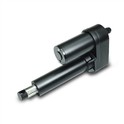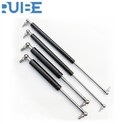As a seasoned supplier of Sofa Gas Spring, I've witnessed firsthand the pivotal role these components play in the functionality and comfort of sofas. Sofa gas springs are engineering marvels, combining various materials to deliver reliable performance. In this blog, we'll delve into the materials used in sofa gas springs, exploring their properties, advantages, and how they contribute to the overall quality of these essential furniture components.
Steel: The Foundation of Strength
Steel is the most commonly used material for the outer tube and piston rod of sofa gas springs. Its exceptional strength and durability make it an ideal choice for withstanding the forces exerted during the operation of the gas spring. High - carbon steel is often selected due to its superior hardness and resistance to wear.
The outer tube, typically made of steel, serves as the housing for the internal components of the gas spring. It must be able to contain the pressurized gas and provide a stable structure. A well - made steel outer tube can resist corrosion, ensuring a long service life even in humid or harsh environments. The smooth surface finish of the steel tube also allows for the proper movement of the piston rod inside.
The piston rod, another critical part made of steel, is responsible for transferring the force from the sofa's movement to the internal mechanism of the gas spring. It needs to be straight and have a high surface finish to prevent friction and ensure smooth operation. Steel piston rods are often treated with special coatings, such as chrome plating, to enhance their corrosion resistance and reduce wear.
Gas: The Power Source
The gas inside a sofa gas spring is a key factor in its operation. Nitrogen is the most commonly used gas in these applications. Nitrogen is an inert gas, which means it does not react chemically with other materials inside the gas spring. This property makes it safe and reliable for long - term use.
The pressure of the nitrogen gas inside the gas spring determines its lifting force. By adjusting the gas pressure, manufacturers can customize the gas spring to meet the specific requirements of different sofas. For example, a larger and heavier sofa may require a gas spring with higher gas pressure to provide sufficient lifting power.
The gas is sealed inside the gas spring using a series of seals and gaskets. These seals must be made of materials that can withstand the high pressure of the gas and prevent leakage. Elastomers, such as rubber, are commonly used for these seals due to their flexibility and ability to form a tight seal.
Seals and Gaskets: Preventing Leakage
Seals and gaskets are essential components that ensure the proper functioning of a sofa gas spring. As mentioned earlier, they are responsible for preventing the leakage of the gas inside the gas spring.
Rubber is a popular material for seals and gaskets in sofa gas springs. Natural rubber or synthetic rubber compounds are used depending on the specific requirements of the application. Rubber has excellent elasticity, which allows it to conform to the surfaces of the gas spring components and create a tight seal. It also has good resistance to wear and tear, ensuring a long service life.
In addition to rubber, some high - performance seals may use other materials, such as fluorocarbon elastomers. These materials offer even better resistance to high temperatures, chemicals, and ozone, making them suitable for more demanding applications.


Plastic Components: Lightweight and Functional
Plastic components are also used in sofa gas springs, mainly for their lightweight and cost - effectiveness. Some gas springs may have plastic end caps or guides.
Thermoplastics, such as polypropylene or polyethylene, are commonly used for these plastic parts. These materials are easy to mold into various shapes, allowing for the production of complex designs at a low cost. Plastic end caps can protect the ends of the gas spring from damage and provide a clean and finished appearance.
Plastic guides are used to ensure the proper alignment of the piston rod and other moving parts inside the gas spring. They reduce friction and noise during operation, improving the overall user experience.
Bearings: Ensuring Smooth Movement
Bearings are used in sofa gas springs to facilitate smooth movement between different parts. They reduce friction and wear, allowing the gas spring to operate more efficiently.
Ball bearings are often used in these applications. They consist of small metal balls that roll between two surfaces, reducing the contact area and thus the friction. Ball bearings are made of high - quality steel to ensure durability and smooth operation.
The housing of the ball bearings is usually made of a material that can support the load and provide a stable environment for the balls. This housing material may be steel or a high - strength plastic, depending on the design requirements of the gas spring.
The Importance of Material Selection
The choice of materials for sofa gas springs is crucial for their performance, durability, and safety. Using high - quality materials ensures that the gas spring can withstand the repeated use and stress of daily operation.
For example, if low - quality steel is used for the outer tube or piston rod, it may rust or deform over time, leading to a decrease in performance and potentially causing the gas spring to fail. Similarly, using a substandard gas or seals can result in gas leakage, reducing the lifting force of the gas spring.
As a supplier, we understand the importance of material selection. We work closely with our material suppliers to ensure that we use only the best - quality materials in our Sofa Gas Spring production. This commitment to quality allows us to provide our customers with reliable and long - lasting products.
Related Products and Their Materials
In addition to sofa gas springs, we also offer other related products, such as Massage Chair Lockable Gas Spring and Salon Chair Gas Spring. While the basic principles of these gas springs are similar to those of sofa gas springs, the materials used may vary slightly depending on the specific requirements of the application.
Massage chair lockable gas springs need to be able to withstand the constant movement and vibration during the massage process. Therefore, they may use higher - grade steel and more advanced seals to ensure reliable performance. Salon chair gas springs, on the other hand, may need to be more compact and lightweight while still providing sufficient lifting force. This may require the use of specialized materials and designs.
Conclusion
In conclusion, sofa gas springs are made of a combination of materials, each playing a crucial role in their operation. Steel provides strength and durability, gas is the power source, seals prevent leakage, plastic components offer lightweight and cost - effective solutions, and bearings ensure smooth movement.
As a professional Sofa Gas Spring supplier, we are dedicated to using the highest - quality materials and advanced manufacturing techniques to produce gas springs that meet the diverse needs of our customers. Whether you are a sofa manufacturer, a furniture retailer, or an end - user looking for a replacement gas spring, we have the expertise and products to meet your requirements.
If you are interested in our Sofa Gas Spring, Massage Chair Lockable Gas Spring, or Salon Chair Gas Spring products, please feel free to contact us for more information and to discuss your specific needs. We look forward to establishing a long - term partnership with you.
References
- "Engineering Materials and Their Applications" by J. A. Schey
- "Gas Spring Design and Application Handbook" by various industry experts
- Technical documents from gas spring manufacturers






